![]() THE HALF WAVE VERTICAL (GPA)------ THE 5/8 WAVE VERTICAL-------- MOBILE ANTENNA
THE HALF WAVE VERTICAL (GPA)------ THE 5/8 WAVE VERTICAL-------- MOBILE ANTENNA 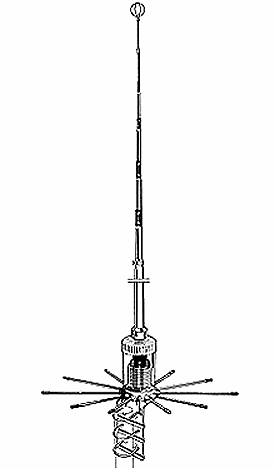
The vertical antenna is as we know it is an omni directional antenna, this means that its radiating field is in all directions equal.
On the 11 meter band we can come across various types:
the mobile antenna
the 1/4 wl vertical
the 1/2 wl vertical
the 5/8 wl vertical
the 3/4 wl vertical
All these antennas have there own capabilities. And there are many variants within those mentioned above. Luckily we can bring all back to the basic.
First we will get ride of some misunderstandings:
It is just not possible that a 5/8 wave vertical is several S-units stronger then a half wave. (in local conversations) The person who thinks this was the case with him, has probably have to take a look for an answer in a other direction say..height, new coax, perhaps the connectors are connected now correct, in the worst case the receiving S-needle is just way to optimistic.
It is possible from time to time in DXing situations but this is only due to different take-off angles.
The Gain produced by a half-wave vertical(Antron 99/Bandit etc) is nothing over a Dipole. Because it is a Dipole., all stories with gain (11dBI etc...) not true!
The Gain produced by a 5/8 wave vertical is about 1,5 dB over a Dipole. anything else is not true!
Overall, there is no different between antennas with the same length except diameter, price, how the antenna is made resonant (SWR). But the electrical capabilities are all the same!
With antennas longer then 5/8 wavelength, the DX results will go down. The reason for this is that the bundle of radiation brakes up in to several smaller bundles.
There are stories going around in which is mentioned that you must aim the coil in the direction in which you would like the strongest signal, this is not true. It does not matter on which side of the mast you mount the vertical. (Not included dipoles on the side of the mast)
THE ADVANTAGE
A vertical antenna has a very low radiation pattern from its own and does not depend on height as much as a horizontal antenna does (over good ground).
And a vertical antenna is often omni-directional, so extra cost with rotators do not come in.
By going through the site you can learn how the take-off angle is of influence and at what height a horizontal antenna might be better for you.
The low take-off angle is the advantage where DX-expeditions take effort from. But only over good ground this is the case (water, grass etc.) above industrial ground or desert ground this advantage does not exist!
THE DISADVANTAGE
I keep hearing of all the noise stories on the vertical antenna, this just might cause u did not hear that station calling.
The gain (when u do not want to change that omni-directional pattern) is very marginal.
A vertical can cause TVI or any other for of interference at the neighbors this compared to a horizontal one.
All in one the vertical has it pluses and minuses but definitely will never be of the playground when people started looking for an antenna for their purpose.
1/4 Wave - ground plane
An simple and easy to make antenna width a good band width. In this case for 10 and 11m.
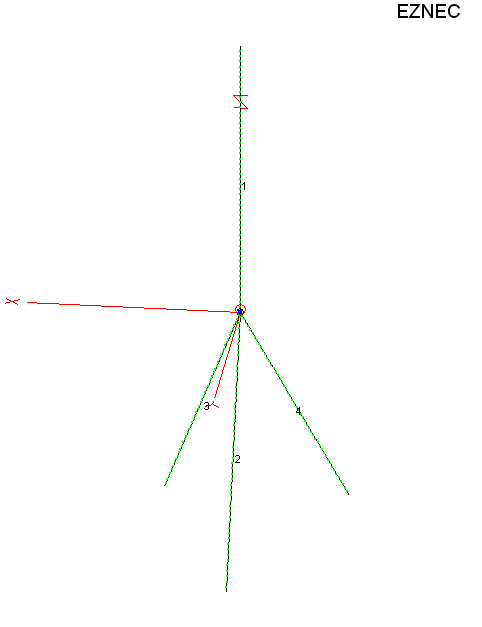
1/4 wave ground plane | ||
| Design freq: | 27,555 MHz | |
| Gain: | 3,99 dBi | |
| F/B: | N.A. | |
| Beam width: | N.A. | |
| Band width | 3,5 MHz (!!) | |
| Tube/Wire | 33mm alu / 1,5mm2 | |
| 1= | 2.500mm 33mm alu | |
| 2= | 2.630mm 1,5mm2 wire | |
| 3= | 2.630mm 1,5mm2 wire | |
| 4= | 2.630mm 1,5mm2 wire |
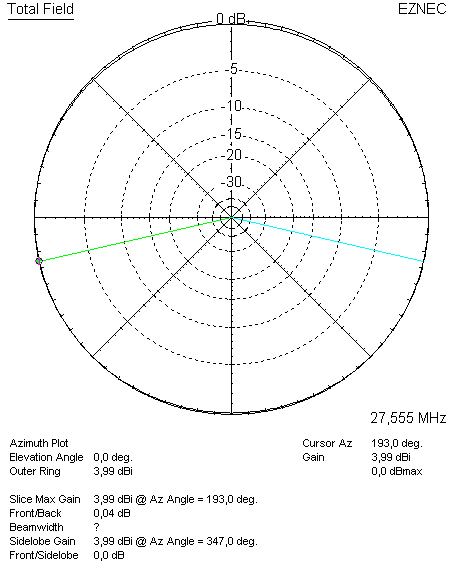
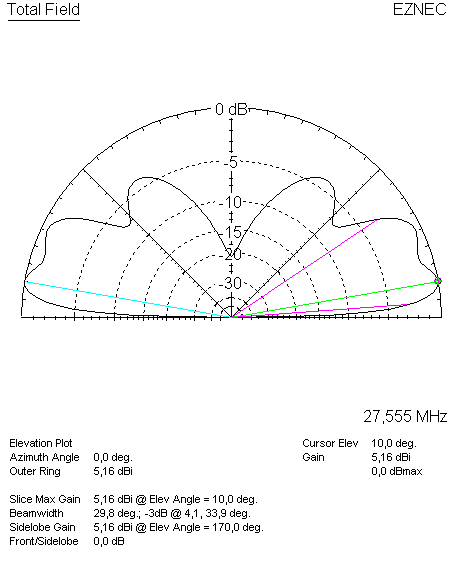
Azimuth plot ----------------------------------------- Elevation plot on 12 meters height
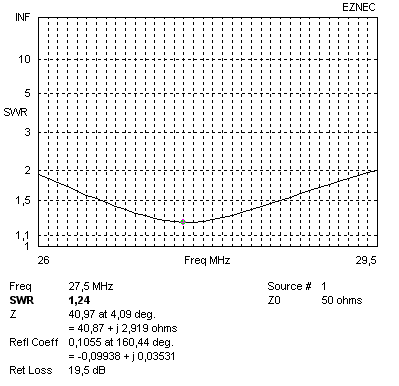
THE HALF WAVE VERTICAL
Probably the best know antenna on our 11 meter band !
Everyone has used this type in the past or will use it somewhere!
Although the half wave vertical comes along with various names the PRINCIPLE is all the same.
The only (electrical) difference, is how the 50 ohms from the coax cable is brought over to the antenna and visa versa.
The reason why this antenna type is so popular are probably the following:
The length is "only" about 5,50 meters
This antenna does not require any radials
Easy to erect!
To construct this antenna most use black markings on the aluminum to judge the length and give the user a satisfying S.W.R.
But there are also those who use other technics to control the S.W.R. in such away that it becomes possible to change the SWR from the bottom of the antenna.
The theory behind this antenna is quite simple, its as the name says a half wavelength long tube or wire with its feeding point at the end.
With that comes a high impedance, we overcome that problem by putting in a transfer device to put that impedance back to around 50 ohms. This always includes some type of a coil. It can be a small one made on a print for or a strong solid one. Be carefully with those "print" coil types, they can not handle high power.
HOW HIGH SHOULD I PLACE THE 1/2 Vertical ?
The following diagrams are constructed over good ground.
In the first diagram we see that the take-off angle is quite low (A-16 degrees) while the antenna is only a half meter above the ground!
In the second diagram (B) where the antenna is situated 6 meters above the ground, we see that the take-off angle is in the order of 35 degrees but still at 16 degrees its only several dB's down to the lower one. This means for Real long distance DX the lower antenna will be better of most of the time. In the summer months with the sporadic E openings the antenna situation B will be better most of the time.
When we come to a height of 15 meters we reach the same thing the angles C and D are almost the same as angle A and B .
When the antenna is put as high as 25 meter above the ground the lowest angle is around 5 degrees (G) and there are several side-lobs higher (F/E)
Conclusion:
A vertical (half wave) almost sitting at the ground IS capable of working DX! ( better then any horizontal antenna at that height! )
But placing a half wave vertical much higher is not always favorable.
For this height reason, DX-expeditions sometime favor vertical antennas!
RADIAL KIT:
Although there are those who sell an additional radial kit there is almost no difference when you add these radials to the antenna
This antenna-type does not require one.
GAIN
Another issue is the gain, since it's electrical length is only a half wave. You can look to it as a Dipole (only end fed),
Now you'll probably realize that the antenna does not have the gain many manufacturers would like you to think it has, measured the right way.
The gain of the antenna is 2,14 dBI in free space.
There is NO WAY you can produce 10dBI or more from these kind of antennas. If anyone can produce this there will be no use for a 5 or 6 elements yagi !
Finally it is of no influence how pretty the antenna is with fiberglass/without..there are those with light bolds on top etc etc..don't care about that. The basic counts..

THE 5/8 WAVE VERTICAL
This type used by many, It has deserved a name on the DX-antenna list over the last years.
Often bought by those who have a 1/2 wave vertical but want to put more effort in the antenna system.
The radiation pattern is also a omni-directional one. It has somewhat higher gain then his smaller brother (the half wave vertical), actually it is 1,5dB stronger.!!!
And yes, this difference is "just" noticeable, but no way this will result in an one extra or several extra S-units.
The SWR can often be changed at the bottom of the antenna by changing the coil dimensions, you can easily change the SWR.
Other forms of "tuning" are those with changing the total antenna length by changing the top element, often you will not have to change anything since the manufacturer has put markings on the aluminum.
Some manufacturers would like to let you know that with something on top of the antenna (as you can see in the picture above) the antenna will work better this of course is also not true....but it looks nice.
And there are those who claim high gain. As said the 5/8 wave antenna has 1,5dBD NO more, no matter what type!
LONGER THEN A 5/8 WAVE
For us DXers it has no advantage of building or buying a vertical antenna with a longer length then about 7 meters.
The take-off angle will not be any lower and the longer antenna brings along more lobs in the antenna pattern
which are divided many times so they tend to be weaker.
Above we see the pattern produced by a 5/8 wave antenna with a length just under 7 meters. When you compare this to a halve wave vertical you can notice there is only a slight difference, NOT that much though.
Looking at A the angle is again around the 16 degrees, the antenna is only situated 0,5 meters above the ground!
At B you can see that the take-off angle is very wide even the noticeable dip in the pattern is only 1 dB down to its strongest point! so this will suite you just fine for all DX.
With C (15 meters) and D (25 meters)we come in the lower take-off angles the
serious DX is found there. But the antenna is already up quite a bit and a small horizontal placed beam at these heights
will outperform the vertical almost anytime.

No comments:
Post a Comment